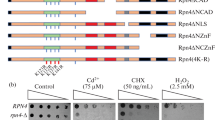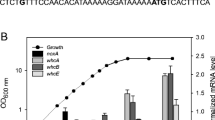Abstract
This work aimed to assess novel protective roles and regulation of Spy1, a histidine-containing phosphotransfer (HPt) protein, in the fission yeast Schizosaccharomyces pombe. The structural gene encoding Spy1 was cloned into the shuttle vector pRS316 to generate the recombinant plasmid pYFSpy1. The spy1 + mRNA level was notably increased in S. pombe cells harboring the plasmid pYFSpy1. The S. pombe cells harboring pYFSpy1 exhibited higher survival than the vector control cells on the minimal media plates with nitric oxide (NO)-generating sodium nitroprusside (SNP) or without nitrogen source. In the liquid minimal media, they also showed higher viability under nitrosative stress or nitrogen-starved condition. The intracellular reactive oxygen species (ROS) level appeared to be lower in the fission yeast cells harboring pYFSpy1 than in the control yeast cells. Overexpression of the spy1 + gene showed scavenging effect on NO generated from SNP. Synthesis of β-galactosidase from the spy1 +-lacZ fusion gene was significantly enhanced by SNP and nitrogen starvation in the Pap1-positive but not in the Pap1-negative cells. The spy1 + mRNA level in S. pombe was also elevated by SNP and nitrogen starvation in the Pap1-positive but not in the Pap1-negative cells. In summary, Spy1 plays protective roles against nitrosative and nutritional stress in the fission yeast and is transcriptionally up-regulated by nitrosative and nutritional stresses in a Pap1-dependent manner.







Similar content being viewed by others
Abbreviations
- NO:
-
Nitric oxide
- ONPG:
-
ο-Nitrophenyl-β-d-galactopyranoside
- PCR:
-
Polymerase chain reaction
- ROS:
-
Reactive oxygen species
- RT-PCR:
-
Reverse transcriptase-polymerase chain reaction
- SNP:
-
Sodium nitroprusside
- S. pombe :
-
Schizosaccharomyces pombe
References
Imamura A, Hanaki N, Umeda H, Nakamura A, Suzuki T, Ueguchi C, Mizuno T (1998) Response regulators implicated in His-to-Asp phosphotransfer signaling in Arabidopsis. Proc Natl Acad Sci USA 95:2691–2696
Lu JM, Deschenes RJ, Fassler JS (2003) Saccharomyces cerevisiae histidine phosphotransferase Ypd1p shuttles between the nucleus and cytoplasm for SLN1-dependent phosphorylation of Ssk1p and Skn7p. Eukaryot Cell 2:1304–1314
Porter SW, West AH (2005) A common docking site for response regulators on the yeast phosphorelay protein YPD1. Biochim Biophys Acta 1748:138–145
Aoyama K, Mitsubayashi Y, Aiba H, Mizuno T (2000) Spy1, a histidine-containing phosphotransfer signaling protein, regulates the fission yeast cell cycle through the Mcs4 response regulator. J Bacteriol 182:4868–4874
Aoyama K, Aiba H, Mizuno T (2001) Genetic analysis of the His-to-Asp phosphorelay implicated in mitotic cell cycle control: involvement of histidine-kinase genes of Schizosaccharomyces pombe. Biosci Biotechnol Biochem 65:2347–2352
Takatsume Y, Izawa S, Inoue Y (2006) Methylglyoxal as a signal initiator for activation of the stress-activated protein kinase cascade in the fission yeast Schizosaccharomyces pombe. J Biol Chem 281:9086–9092
Lenormand JL, Dellinger RW, Knudsen KE, Subramani S, Donoghue DJ (1999) Speedy: a novel cell cycle regulator of the G2/M transition. EMBO J 18:1869–1877
Toone WM, Kuge S, Samuels M, Morgan BA, Toda T, Jones N (1998) Regulation of the fission yeast transcription factor Pap1 by oxidative stress: requirement for the nuclear export factor Crm1 (exportin) and the stress-activated MAP kinase Sty1/Spc1. Genes Dev 12:1453–1463
Fujii Y, Shimizu T, Toda T, Yanagida M, Hakoshima T (2000) Structural basis for the diversity of DNA recognition by bZIP transcription factors. Nat Struct Biol 7:889–893
Toda T, Shimanuki M, Yanagida M (1991) Fission yeast genes that confer resistance to staurosporine encodes an AP-1 like transcription factor and a protein kinase related to the mammalian ERK1/MAP2 and budding yeast FUS3 and KSS1 kinases. Gens Dev 5:60–73
Kang MH, Park EH, Lim CJ (2007) Protective role and regulation of Rad9 from the fission yeast Schizosaccharomyces pombe. FEMS Microbiol Lett 275:270–277
Kang GY, Park EH, Lim CJ (2008) Molecular cloning, characterization and regulation of a peroxiredoxin gene from Schizosaccharomyces pombe. Mol Biol Rep 35:387–395
Lee EH, Hyun DH, Park EH, Lim CJ (2010) A second protein disulfide isomerase plays a protective role against nitrosative and nutritional stresses in Schizosaccharomyces pombe. Mol Biol Rep. doi:10.1007/s11033-010-0018-1
Kim SJ, Choi YS, Kim HG, Park EH, Lim CJ (2006) Cloning, characterization and regulation of a protein disulfide isomerase from the fission yeast Schizosaccharomyces pombe. Mol Biol Rep 33:187–196
Kim HJ, Jung HY, Lim CJ (2008) The pap1+ gene of fission yeast is transcriptionally regulated by nitrosative and nutritional stresses. FEMS Microbiol Lett 280:176–181
Myers AM, Tzagoloff A, Kinney DM, Lusty CJ (1986) Yeast shuttle and integrative vectors with multiple cloning sites suitable for construction of lacZ fusions. Gene 45:299–310
Guarente L (1983) Yeast promoters and lacZ fusions designed to study expression of cloned genes in yeast. Methods Enzymol 101:181–191
Bradford MM (1976) A rapid and sensitive method for the quantitation of microgram quantities of protein utilizing the principle of protein-dye binding. Anal Biochem 72:248–254
Sherman MP, Aeberhard EE, Wong VZ, Griscavage JM, Ignarro LJ (1993) Pyrrolidine dithiocarbamate inhibits induction of nitric oxide synthase activity in rat alveolar macrophages. Biochem Biophys Res Commun 191:1301–1308
Royall JA, Ischiropoulos H (1993) Evaluation of 2′,7′-dichlorofluorescin and dihydrorhodamine 123 as fluorescent probes for intracellular H2O2 in cultured endothelial cells. Arch Biochem Biophys 302:348–355
Calera JA, Herman D, Calderone R (2000) Identification of Ypd1, a gene of Candida albicans which encodes a two-component phosphohistidine intermediate protein. Yeast 16:1053–1059
Gutteridge JM (1993) Anthracycline toxicity, iron and oxygen radicals, and chelation therapy. J Lab Clin Med 122:228–229
Nordberg J, Arnér ES (2001) Reactive oxygen species, antioxidants, and the mammalian thioredoxin system. Free Radic Biol Med 31:1287–1312
Ketela T, Brown JL, Stewart RC, Bussey H (1998) Yeast Skn7p activity is modulated by the Sln1p-Ypd1p osmosensor and contributes to regulation of the HOG pathway. Mol Gen Genet 259:372–378
Hayashi M, Maeda T (2006) Activation of the HOG pathway upon cold stress in Saccharomyces cerevisiae. J Biochem 139:797–803
Panadero J, Pallotti C, Rodríguez-Vargas S, Randez-Gil F, Prieto JA (2006) A downshift in temperature activates the high osmolarity glycerol (HOG) pathway, which determines freeze tolerance in Saccharomyces cerevisiae. J Biol Chem 281:4638–4645
Freeman JA, Bassler BL (1999) Sequence and function of LuxU: a two-component phosphorelay protein that regulates quorum sensing in Vibrio harveyi. J Bacteriol 181:899–906
Nguyen AN, Lee A, Place W, Shiozaki K (2000) Multistep phosphorelay proteins transmit oxidative stress signals to the fission yeast stress-activated protein kinase. Mol Biol Cell 11:1169–1181
Barnes EA, Porter LA, Lenormand JL, Dellinger RW, Donoghue DJ (2003) Human Spy1 promotes survival of mammalian cells following DNA damage. Cancer Res 63:3701–3707
Gastwirt RF, Slavin DA, McAndrew CW, Donoghue DJ (2006) Spy1 expression prevents normal cellular responses to DNA damage: inhibition of apoptosis and checkpoint activation. J Biol Chem 281:35425–35435
McAndrew CW, Gastwirt RF, Donoghue DJ (2009) The atypical CDK activator Spy1 regulates the intrinsic DNA damage response and is dependent upon p53 to inhibit apoptosis. Cell Cycle 8:66–75
Golipour A, Myers D, Seagroves T, Murphy D, Evan GI, Donoghue DJ, Moorehead RA, Porter LA (2008) The Spy1/RINGO family represents a novel mechanism regulating mammary growth and tumorigenesis. Cancer Res 68:3591–3600
Acknowledgements
This research was supported by Basic Science Research Program through the National Research Foundation of Korea (NRF) funded by the Ministry of Education, Science and Technology (2009-0072536). The authors wish to acknowledge Ms Sun-Young Ji for her technical assistance.
Author information
Authors and Affiliations
Corresponding author
Additional information
The sequence reported in this paper has been deposited in the GenBank database with the accession number AL034352.
Rights and permissions
About this article
Cite this article
Kang, MH., Jung, HJ., Hyun, DH. et al. Protective roles and Pap1-dependent regulation of the Schizosaccharomyces pombe spy1 gene under nitrosative and nutritional stresses. Mol Biol Rep 38, 1129–1136 (2011). https://doi.org/10.1007/s11033-010-0210-3
Received:
Accepted:
Published:
Issue Date:
DOI: https://doi.org/10.1007/s11033-010-0210-3




